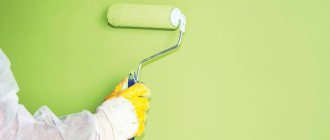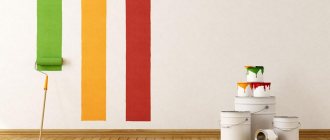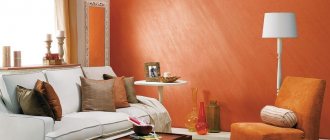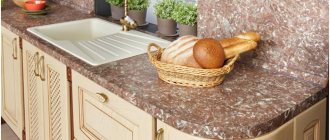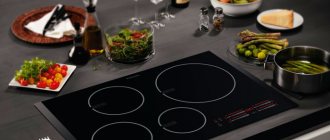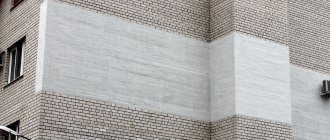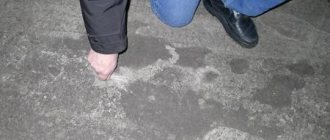Drywall is one of the most popular materials for renovation and construction. Its sheets can be used to create partitions, various structures or simple decoration of walls and ceilings. You can get a beautiful result with the help of finishing. We tell you how and with what to paint drywall to achieve a good result.
Requirements for the structure to be painted
Preparation for painting begins at the stage of assembling the frame and covering it with plasterboard sheets. The structure should be monolithic, seamless and stable, since the slightest shifts of the sheets will lead to cracks and peeling, and the drywall paint will begin to crumble.
Therefore, the frame elements are rigidly connected to each other, and the cladding is screwed onto it with special self-tapping screws, ensuring reliable fixation. In new wooden houses subject to shrinkage, a so-called floating frame is installed, and gaps are left between the sheathing sheets and the plane of the floor and ceiling. In addition, the design must have perfectly correct planes and angles, otherwise the paint will highlight all the defects and differences at the joints.
Experienced finishers always take such nuances into account, so it is better to trust only them with the construction of plasterboard partitions, cladding of ceilings and walls. Source prorab.help
Certain requirements are also imposed on the surface itself. The surface of plasterboard is a multilayer paper that gets wet, swells upon contact with a damp substance, and unevenly absorbs paint. If a plasterboard ceiling is painted directly over it, the surface will not have an aesthetic appearance.
Clearly visible seams between the sheets, even if the installation is done very carefully, and the heads of metal screws showing through the paint, from which the coating will peel off very quickly, will not add beauty to it.
There is only one way to avoid this - by covering the surface with a thin layer of putty. It performs several functions at once:
- protects the paper layer from moisture and reduces its absorbency;
- hides joints and fastenings;
- evens out the color of the surface.
An attempt to save money and putty only the seams, recesses from self-tapping screws and surface defects before painting the drywall often leads to uneven painting, especially when using light-colored water-based compounds.
Such a surface cannot be painted; it must be completely puttied. Source mirbetona.info
Features of drywall
Drywall consists of two sheets of special cardboard and gypsum filler. Various substances are also added to it, which can give the material different properties. Despite the fact that gypsum board is a modernized cardboard, manufacturers have not yet been able to completely eliminate the fact that it absorbs all moisture. Therefore, before painting, careful preparation of the surface is necessary, otherwise a lot of paint will be needed. In addition, due to the fact that cardboard is capable of absorbing the composition at different rates, without a layer of putty you will not achieve a uniform result.
The material requires pre-treatment for another reason: if it is not done, any irregularities on the gypsum board will be very noticeable. Sheets that serve as a base and, for example, hide a sewer riser or very uneven walls, are rarely sanded in advance. It is often assumed that they will be covered with some kind of material: in a bathroom this could be tile. Therefore, the surface of the gypsum board is not very smooth.
Pixabay
Pixabay
Surface preparation algorithm
Since the answer to the question of whether it is possible to paint drywall without preparation is definitely negative, you need to figure out how to properly carry out this preparation. The whole process can be divided into several stages.
- Inspect the surface for cracks, protruding joints, poorly screwed screws protruding beyond the surface.
- Treatment with acrylic primer for better adhesion to putty.
To prevent the paper from absorbing moisture from the solution, the surface is primed Source obustroeno.com
- Reinforce joints with masking tape and reinforce corners.
- Puttying joints, corners, fastening holes and surface defects.
- Rubbing the putty after drying.
- Applying a continuous thin layer of putty.
- Sanding the surface after the putty has dried.
- Re-priming with 2 layers of penetrating primer.
For leveling, use gypsum or polymer finishing putty. Source gipsmontaj-st.ru
A detailed description of all these processes is in other materials on the site; if necessary, you can familiarize yourself with them.
See also: Catalog of companies that specialize in paints and varnishes and related work
How to putty GVL for painting and wallpaper
Decorative painting and wallpapering are the most popular options for finishing surfaces lined with gypsum fiber board. Maximum smoothness can only be achieved by filling everything, the joints between the slabs, and the exposed screws. All work will be done in three stages:
- padding;
- preliminary puttying of the place where the sheets are glued;
- final puttying of the entire surface, finishing stage.
Do not forget that special dilutable compounds will be required for the installation of gypsum fiber board elements.
Choosing paint and tools
When everything is ready for the final finishing, it’s time to decide how to paint the drywall - what paint to choose and what tool is best to apply it.
Types of paints suitable for gypsum boards
Before choosing a coloring composition, determine the color and the requirements for it. This may be the coating’s resistance to wet cleaning, degree of abrasion, drying speed, lack of odor, environmental friendliness, etc.
Since the paint is applied not to the drywall itself, but to the putty, a variety of compositions are suitable for painting it. But most often, water-based paints are chosen for interior work in residential buildings, and alkyd enamels are used for finishing surfaces in rooms with high humidity and the need for frequent cleaning.
Walls and ceiling painted with acrylic water-based emulsion Source melbournepainting.services
Painting drywall with water-based paint allows you to choose any desired shade and surface texture. Even if the desired color is not among the ready-made compositions, it is obtained by mixing a white base with a tinting pigment. Whether the wall will be perfectly smooth or slightly rough depends on the choice of tool.
The basis of any water-based emulsion is water, and the paint is diluted with it to obtain the desired consistency. The properties of paint depend on what components are included in its composition.
- Acrylics are the most popular and inexpensive. Most of them are not very resistant to moisture, so they can only be used for decorating dry rooms. But there are also moisture-resistant compounds that can withstand wet cleaning.
- Latex ones are more resistant to both moisture and abrasion, do not absorb dirt, are easy to apply and last a long time.
Latex paint for ceilings Source stroylandiya.ru
- Silicone coatings are the most expensive, but at the same time the most convenient to use coatings, especially for rooms where temperature changes, increased air humidity, and the appearance of mold are possible. They can be cleaned, washed, and disinfected without harm to their appearance.
- Silicate paints are similar in properties to silicone paints, but the liquid glass they contain makes the surface impenetrable not only to water, but also to air.
To install GVL on walls, you need to carry out some preparatory work:
- all old coverings are removed to the ground. The minimum possible interaction of the element with other building materials is required;
- if the base is concrete, then you need to carefully remove all elements that have already begun to peel off. So that the surface for working with gypsum plasterboard is free of noticeable flaws;
- if it turns out that there are several concrete slabs on one surface, additional work with the seams will be required. They need to be completely eliminated. In any hardware store you can easily find the latest generation of plastic compounds. They can fill in the gaps very well. How to putty GVL is discussed below.
In addition to interior wall treatment indoors, gypsum fiber sheets are also excellent for outdoor use. There are many features when facing walls with gypsum fiber board. They can simply be glued to the wall, or they can be mounted on profiles.
If a frameless cladding option is chosen, the joints are sealed with a special material. Putty with the required markings is available in all building materials stores. With this finish, no reinforcing tape is required.
But to skip this stage of work, you can take care of it right away. A wide range of different types is available in building materials stores. In addition to the main characteristics of resistance to moisture, low flammability and high thermal insulation, they are available with a polished surface and a regular one. And the edges can be chamfered or without them. If the edges are chamfered, then the joints are much stronger and less noticeable. These seams also do not require reinforcing tape.
Dyeing technology
Before painting drywall, you should prepare the paint by mixing it thoroughly and, if necessary, diluting it with water or a recommended solvent. The volume of liquid for dilution should not be more than indicated in the instructions.
If you decide to tint the paint, then it is better to do it in a store where there are special machines. It is impossible to achieve the same shade in each jar on your own; you will have to pour them into one large container and tint the entire volume.
Advice! Before painting plasterboard walls, it is recommended to do test paints and let them dry to evaluate the actual color of the future coating. If necessary, you can adjust the shade by adding a little color or a white base.
After drying, the paint may slightly change shade Source forum.ivd.ru
To work, you will need a paint bath, a spatula for mixing paint and masking tape. To avoid staining floors or furniture, they are covered with film.
- A portion of paint is poured into the bath.
- First, paint with a brush all those areas where it is impossible to reach with a roller or where it can stain the adjacent surface - internal corners, the area along the baseboards and cornices, niches, etc.
- The main area is treated with a roller, which is dipped in paint and rolled along the ribbed surface of the tray to remove excess paint.
- Drywall paint for walls is applied from top to bottom, the ceiling is painted in parallel stripes from one to the opposite wall.
- After treating a small area, immediately roll it over again without dipping it into paint - this technique allows you to remove drips.
If individual areas need to be painted a different color, they are covered along the border with masking tape Source interieurdesigner.be
The minimum number of layers of paint is two. The second and subsequent ones are applied to the dried surface in a direction transverse to the previous one. The quality of painting is checked using a bright lamp directed at an angle to the surface. If necessary, the defective area can be sanded and repainted.
DIY drywall painting
First, the drywall must be properly prepared and processed. It is necessary to check the sheets for strength, tightness and reliability of fastenings. When working, be sure to follow safety precautions and not allow paint to get on exposed skin. The room must be well ventilated and no open fire should be left near the workplace.
Preparatory activities begin with a thorough check for defects and surface treatment for application of products. The sheets must be tightly fitted to each other, the joints processed and sealed. The fastener caps should be sealed with a special tape and coated with a primer.
Can this be done without applying putty?
To understand whether it is possible to paint drywall with water-based paint without putty, you need to take a closer look at the positive aspects of the puttying process:
- Strengthening the coating. The top layer of gypsum board consists of cardboard, which absorbs moisture very well. If you do not additionally putty the sheet, the strength of the drywall can be significantly reduced.
- Increased coating adhesion, improved adhesion of paint to sheet.
- Reducing paint consumption by creating a water-repellent surface.
- Aligning paint color. Without additional coverage, the product will absorb and dry unevenly, leaving stains and gaps.
To understand whether it is necessary to additionally putty the drywall before painting, you need to decide on the purpose of the structure. Painting without preliminary putty is suitable for warehouses, production and utility rooms, where quality and beauty are not as important as in residential premises.
What tools will you need?
You can paint drywall with a traditional roller or brush, or you can also use a spray gun for this purpose.
- Spray gun.
The spray gun will greatly facilitate the painting process and allow you to achieve a smooth surface without drips.
A device that greatly facilitates the painting process and allows you to achieve the smoothest possible surface without stains or drips. True, spray guns are much more expensive than rollers and brushes, so if you need to paint a relatively small area, there is no point in buying them.
As a spray gun, you can use a special attachment for a vacuum cleaner, which is almost as good in quality, but at the same time costs much less.
You can use a special attachment on a vacuum cleaner as a spray gun.
- Roller.
Using a roller you can create a “textured” surface effect
The most common tool for painting drywall. With its help, you can apply both enamel paint (the length of the pile on the roller in this case should be no more than 4 millimeters) and water-based paint (the length of the pile is 4–8 millimeters). In addition, using a roller you can create the effect of a “textured” surface. To do this, you must use a roller with a pile length of more than 8 millimeters.
It is not recommended to use foam rollers when painting drywall.
When painting one room, it is better to use the same roller attachment. When purchasing a roller, we recommend that you pay attention to models with sliding telescopic handles, since such a tool will make painting in hard-to-reach places much easier.
- Brush.
The brush is used for “finishing”: painting in corners, behind radiators and in other “inconvenient” places
As a rule, a brush is used not for basic painting, but for “finishing”, that is, painting in corners, behind radiators and in other “inconvenient” places. For these purposes, a brush with a width of 40–60 millimeters is suitable. If you are going to paint the entire surface with a brush, then, naturally, you need to use a wider tool.
The process of painting plasterboard walls
During work, it is necessary to ventilate the room well and use protective clothing. Application should begin with window and door openings. Wall treatment begins after the paint on the ceiling has completely dried. It is advisable to apply the paint in two or three even layers so that the finish coat does not show through.
The first layer of paint should be applied from top to bottom, and the second from left to right. The paint must be poured into a special flat container, gradually and in small portions as it is used. Painting drywall without putty occurs in a certain sequence.
First, the corners and the area behind the batteries are processed. Next, the rest of the surface is painted. The roller is lowered into a container with the product, rolled over the entire area and excess product is removed from the sides. You need to move the roller over the surface smoothly, without sudden jerks, and make sure that no smudges form.
Important! To clean tools, clothing and the skin of your hands, it is strictly forbidden to use leaded gasoline, benzene and toluene. If they come into contact with exposed skin or eyes, these substances can cause severe chemical burns.
After all layers have dried, decoration is performed. It is necessary to monitor the uniformity of the product and the thickness of the final layer. When using several colors of paint, the borders are taped with masking tape.
What kind of paint can be used
Before you start work, you need to decide whether in this case it is possible to paint drywall without using putty, because this will significantly reduce the quality of the decorative coating. To paint plasterboard structures with your own hands, it is advisable to use a composition that does not emit an unpleasant odor either during its application or after.
For application in the kitchen or bathroom, it is better to use products that form a surface suitable for dry cleaning and washing. A coloring agent for gypsum boards must have several mandatory properties:
- safety;
- strength and moisture resistance;
- long service life.
Acrylic paints have similar properties to water-based paints, but they tolerate moisture better. They have an elastic, dense structure and provide even coverage. The paints are made from acrylic resins and do not emit harmful substances into the air.
Note! It is recommended to use acrylic paint only at an air temperature of at least +10 degrees Celsius. If the temperature is lower, the paint will begin to mix poorly and harden, causing the coating to be uneven and streaky.
Alkyd enamels are used to obtain a durable and water-repellent coating. It contains alkyd varnish, which is why the product has a pungent odor. It can only be applied in a well-ventilated area.
Oil-based products are highly durable and resistant to fire. They dry quickly, but have a strong unpleasant odor and release harmful substances into the air at the time of application. Before painting, the gypsum board should be treated again with an additional layer of primer and PVA glue.
Water-based paints are made from distilled water, so they do not have an unpleasant odor and do not fade in the sun. The main disadvantages of this composition are its inability to repel moisture and the need to periodically renew the paint layer. Coating gypsum plasterboard with water-based emulsion is designed for any premises and is well suited for decorating drywall on internal surfaces. Can be used as a base for wallpaper.
Silicone paint is made from a polymer base that helps protect drywall from damage by repelling dirt and water. The only disadvantages of this product are its high cost and the need to update the coating from time to time.
Technology of applying putty to the wall with a roller
Primer of walls before finishing putty
How to properly putty drywall for finishing
Source
Apply paint
Painting the walls any color in the bathroom is a simple matter.
After opening the package, mix the contents thoroughly until smooth. At this stage, tinting agents or thinning components are added.
First, hard-to-reach areas are painted - they make edging along the top and bottom, around doors, windows, and paint corners and joints with a brush.
A larger surface is painted with a roller. It is important to immediately remove any stains that appear so as not to spoil the appearance of the wall.
Let the first layer dry. The manufacturer writes the drying time on the packaging. Afterwards you can apply a new layer.
